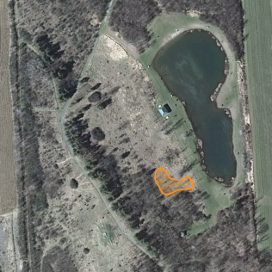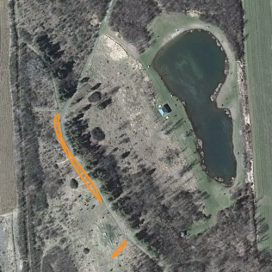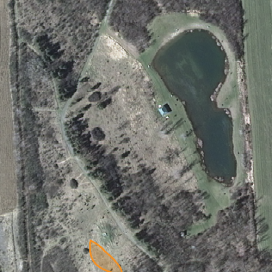Except were noted, the following bare-root tree seedlings, were planted in 18″ tree shelters with 3-ft. square landscape fabric mats surrounding them. The mats will eventually be covered with mulch.
 |
| Approximate location of American chestnut and white pine planting, April 16-20 2015. Basemap is from USGS April 3, 2012. |
Thursday, April 16 – John H., Joe P., and Randy N. planted about 35 bare-root pure (non-blight-resistant) American chestnut (Castanea dentata) trees on the slope west of the fishing pond. These trees were ordered through the American Chestnut Foundation, but were sent from Native Forest Nursery in Chatsworth Georgia. On this day, the seedlings, which averaged about 3-ft. high, were planted by excavating a hole about a foot in diameter and a foot deep. The soil was broken up before returning it to the hole and the roots were spread out to fill the hole. These seedlings were not soaked in water ahead of time and were only misted occasionally with a solution of Miracle-Gro 100070 Plant Food for Azaleas, Camellias, and Rhododendrons (formerly known as Miracid). It was a warm, sunny, and breezy day, so some drying of some of the roots may have occurred. The soil itself was moist and some rain fell that evening and the next day. Five-foot-high, 20″-diameter wire cages were added around a few of the of the seedlings and will eventually be added to all of the American chestnut trees to prevent deer browsing.
 |
| Approximate location of sugar maple planting, April 17, 2015. |
Friday, April 17 – Joe P. and Randy N. planted 50 sugar maples (Acer saccharum) under the Scots pines on the ridge west of the fishing pond. These non-native pines are probably nearing the end of their life-spans and will act as nurse trees for the maples. The maple seedling roots were soaked in water for a few hours before the planting and left water bucket during the planting of the others. These seedlings, most shorter than 18″, were planted using a spade as a planting bar. Tree mats were not included at this time, but will be added where weed competition occurs under the pines.
Saturday, Sunday & Monday, April 18-20 – Randy N. planted 50 white pines (Pinus strobus) in the vicinity of where the chestnuts were planted. This was done to eventually acidify the soil to a level more appropriate for chestnuts, but the relative growth rates will need to be monitored to ensure that the chestnuts are not shaded out. A planting method similar to Friday’s sugar maple planting was employed. The un-planted pine seedlings were left in water from Saturday morning until planting was completed, which is longer than recommended, but the alternatives at this point were unclear.
 |
| Approximate location of red oak planting, April 23, 2015. |
Thursday, April 23 – Paul M. and Randy N. planted 5o northern red oaks (Quercus rubra) at the southern end of the same area after soaking the oaks in water for several hours. These seedlings were planted about 6-ft. from each other in tree shelter tubes supported by thin 3-ft. bamboo stakes instead of the more substantial 1×1 black-locust or 3/4 x 2-inch SPF stakes used for previous seedlings planted. Using round stakes may allow the wind to blow the tubes around more, but adding mats and mulch should hold them more steady. Due to the close spacing, these trees should be monitored and not allowed to become too large before transplanting some of them to a more appropriate location.
Also planted the remaining 15-20 American chestnuts (Castanea dentata) which seemed to have dried out somewhat since their last spraying a week earlier. They had been stored in a cool garage in the large thick paper bag that they had arrived in. These were soaked in pond water during planting into very moist soil.
 |
| Approximate location of redcedar (orange) and whitecedar (red) planting, April 26, 2015. |
Sunday, April 26 – Marcellus Scout Troop 66 planted 50 “cedar” tree seedlings, including 30 American arborvitae/whitecedar (Thuja occidentalis) and 20 eastern redcedar/red juniper (Juniperus virginiana). The cedars were planted in three relatively straight rows with 6-ft. spacing. The upper (western) row is redcedar and the lower two rows are whitecedar (mostly). The Scout group also added mats to the cedars as well as to previously-planted red oaks, American chestnuts, and white pines that still needed them. The workers included Scouts Kyle Denka, Devin Sager, and David White, as well as Lisa Mayers, Scott Stearns, Cathie White, and Brian Winoski. Also assisting this day were John H. and Gary McCrary. [A later note (May 3, 2016): For some reason, all of the junipers died. These were replaced with whitecedars in the Fall by John Underhill and Randy. Most of these did survive. On May 1, 2016, Jim Lanning and Randy replaced the few that did die with a mixture of whitecedar, black cherry, and red oak seedlings, and expanded the size of the planting area a bit in the process.]
Thursday, May 7 – Fifty sweet crabapple (Malus coronaria), 25 white oak (Quercus alba), and 25 swamp-white oak (Quercus bicolor) seedlings arrived from Cold Stream Farm in Michigan.
 |
| Approximate location of sweet crabapple planting, May 12, 2015. |
Friday, May 8 – Tuesday, May 12 – Planted the 50 sweet crabapple seedlings, with shelter tubes.
Wednesday, May 13 – Friday, May 15 – Planted the 25 white oak (Quercus alba), and 25 swamp-white oak (Quercus bicolor) seedlings, with shelter tubes.
Tuesday, May 19 – Added landscape-fabric tree mats around the 50 sweet crabapple seedlings. All of these seedlings had leaved-out since planting a week earlier. Noted that many of the American chestnut seedlings planted a month earlier had large leaves, but only a few of the sugar maples planted a few days later had any leaves at all.
 |
| Approximate location of white oak and swamp-white oak planting, May 13, 2015. |
Friday, May 22 – Added landscape-fabric tree mats around most of the 25 white oak and 25 swamp-white oak seedlings. Many of the swamp-white oak seedlings are just starting to leaf out. Only some of the white oak buds look like they are about to break. The soil is still damp just below the surface, but substantial rain or watering is probably needed soon.
Monday, May 25 – Mowed weeds around this year’s chestnut seedlings using a bush scythe. Most chestnuts are fairly-well leaved out. Also mowed around white pines, redcedars and whitecedars. All redcedars appear to be dead, as they did soon after planting. White pines and whitecedars are doing somewhat better, but not all healthy. The mowed plants were primarily tall goldenrod, but also included some grass, gallium, and many bucksuckle resprouts. Some of the mowed material was raked onto the tree mats to act as mulch.
Wednesday, May 27 – Fertigated the chestnuts, pines, whitecedars, crabapples and oaks with about 220 gallons of Miracle-Gro® Water Soluble Azalea, Camellia, Rhododendron Plant Food (30-10-10 – formerly known as MirAcid). It is primarily the chestnuts that that require conditions more acidic than what the area seems to provide, but the label claims that this fertilizer won’t harm other plants. Recommendations for planting tree seedlings generally say not to fertilize at all until the seedlings are established, but the American Chestnut Foundation does recommend using MirAcid once per month during the first two years. In this exercise, the chestnuts were being given priority, and the rest were being given badly needed moisture after a dry month.
 |
| Approximate location of whitecedar planting, June 5, 2015. |
Friday, June 5 – John U. and Randy N. replaced the 20 eastern redcedar/red juniper (Juniperus virginiana) seedlings (none of which appeared to have survived) with 25 American arborvitae/whitecedar (Thuja occidentalis) seedlings from Cold Stream Farm. Watered using buckets from the pond and then got a pretty good rain overnight. Also scythed some more weeds and raked them over the tree mats of cedars and crabapples to act a mulch.
